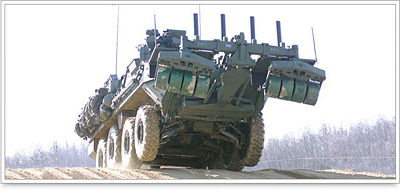M1132 engineer squad vehicle: Difference between revisions
imported>Howard C. Berkowitz No edit summary |
imported>Howard C. Berkowitz No edit summary |
||
| Line 1: | Line 1: | ||
[[Image:M1132 ESV.jpg|thumb|left|400px|M1132 Engineer Squad Vehicle (ESV)]] | [[Image:M1132 ESV.jpg|thumb|left|400px|M1132 Engineer Squad Vehicle (ESV)]] | ||
A representative of a new trend in [[combat engineering vehicle]] (CEV) design, the [[U.S. Army]] '''M1132 engineer squad vehicle (ESV)''' is an example of a "light CEV". They are part of the [[Stryker (armored fighting vehicle)|Stryker wheeled armored fighting vehicle]]] | A representative of a new trend in [[combat engineering vehicle]] (CEV) design, the [[U.S. Army]] '''M1132 engineer squad vehicle (ESV)''' is an example of a "light CEV". They are part of the [[Stryker (armored fighting vehicle)|Stryker wheeled armored fighting vehicle]] family. | ||
It carries a [[combat engineer]] squad and other Engineer resources to the point they are needed, protected against light fire. | |||
==Mission== | ==Mission== | ||
Within the [[Stryker Brigade Combat Team]] (SBCT), the [[combat engineer|Engineer]] element is designed to conduct mobility operations to maintain the momentum of the force. "Engineers must be capable of creating lanes through obstacles (to include surface laid and buried [[mine (land warfare)|minefields]]) to support rapid maneuver and self-extraction. Engineers must also be capable of rubble reduction to support maneuver, especially in a [[urban combat|Military Operations in Urban Terrain (MOUT)]] environment, until other engineer rubble clearance assets can be brought forward."<ref name=PMO>{{citation | Within the [[Stryker Brigade Combat Team]] (SBCT), the [[combat engineer|Engineer]] element is designed to conduct mobility operations to maintain the momentum of the force. "Engineers must be capable of creating lanes through obstacles (to include surface laid and buried [[mine (land warfare)|minefields]]) to support rapid maneuver and self-extraction. Engineers must also be capable of rubble reduction to support maneuver, especially in a [[urban combat|Military Operations in Urban Terrain (MOUT)]] environment, until other engineer rubble clearance assets can be brought forward."<ref name=PMO>{{citation | ||
Revision as of 11:46, 26 July 2010
A representative of a new trend in combat engineering vehicle (CEV) design, the U.S. Army M1132 engineer squad vehicle (ESV) is an example of a "light CEV". They are part of the Stryker wheeled armored fighting vehicle family.
It carries a combat engineer squad and other Engineer resources to the point they are needed, protected against light fire.
Mission
Within the Stryker Brigade Combat Team (SBCT), the Engineer element is designed to conduct mobility operations to maintain the momentum of the force. "Engineers must be capable of creating lanes through obstacles (to include surface laid and buried minefields) to support rapid maneuver and self-extraction. Engineers must also be capable of rubble reduction to support maneuver, especially in a Military Operations in Urban Terrain (MOUT) environment, until other engineer rubble clearance assets can be brought forward."[1]
Traditional CEVs have been heavy vehicles built on tank chassis. Tank-based CEVs are integral parts of tank-centric units, but they are too heavy for quick deployment. Further, they may be too large for urban combat, especially in old cities with narrow streets.
The ESV is smaller and lighter than tank derivatives, which both helps in the urban combat mission and makes it far easier to deploy by air. Nothing is free, however, and it cannot carry out the Engineer breakthrough mission, for large-scale prepared defenses, for which the U.S. Marine Corps developed the Assault Breacher Vehicle.
Design
Some of the design tradeoffs in the M1132, which are assigned to the Engineer Company, Brigade Special Troops Battalion, Stryker Brigade Combat Team (SBCT), have been described by the SBCT Project Management Office:
The operational intent is to bypass obstacles when tactically feasible, utilize stand-off breaching systems where possible and only in an emergency situation utilize mechanical breaching systems that may put the ESV at risk. A system of manned and unmanned (robotics) sensors and clearance devices is required to fully meet this requirement. The ESV with its attachments provides a partial solution to this need, primarily for clearance of hastily emplaced mines on hard surfaces and rubble. The ESV will provide the means for Engineer squad to control future robotic based systems from the protection of the vehicle.[1]
References
- ↑ 1.0 1.1 Engineer Squad Vehicle, U.S. Army Stryker Brigade Combat Team Project Management Office
